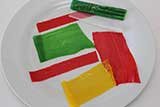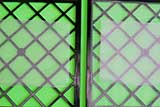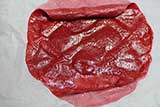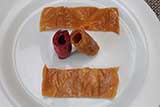Meats and Sausages
Fruit Leathers
Fruit leathers are homemade, chewy dried fruit products, usually in a form of rolls. Fruit rolls are very popular with a younger crowd. Leftover fruit pulp from making jelly can be used for making fruit leather. Fruit leathers can be made from fresh, frozen or canned fruit. Apples, bananas, berries, oranges, pears, peaches, plums, melons and most tropical fruits are suitable for fruit leathers. Grapefruit and lemons taste bitter when dried. They are a healthy choice for diabetics or people on a diet, because they can be made with little (or none) sugar.
The Manufacturing Process
- Select ripe fruit. Remove peel, stems, blossom end and seeds.
- Dice fruit into small chunks. Process fruit in blender until smooth liquid paste is obtained. Certain hard fruits, for example apple, are hard to puree in a blender. Pre-cook apples in a pot until soft juicy pulp is obtained, then blend the pulp in a a processor or a blender.
- Pour the leather into a single large sheet or several smaller sizes.
- Dry.
To prevent darkening of light colored fruit add:
- Two teaspoons of lemon juice or one crushed vitamin C (ascorbic acid) tablet (375 mg).
- Adding sugar is optional. Taste the fruit paste and sweeten with sugar, honey or corn syrup if needed. The advantage of making your own fruit leather is that it can be made without sugar or without sugar substitutes for people on a diet or with health problems.
Spices and Flavorings
- Use whatever ingredients you like, after all you make it for yourself. Think what you would normally use for making jams, jellies or any food. You can read the list of ingredients on commercially made products to get new ideas. For example apples always are made with cinnamon, often with cloves and vanilla. Lemon or orange zest always adds great aroma. Mint agrees with apples, but be careful as it can easily overpower the flavor.
- Ginger goes well with pears, oranges and all other fruits as long as you don't overdose the amount.
- Nutmeg, cardamom, vanilla beans or extract, cloves, cinnamon, a bit of allspice - all those ingredients agree with most fruits.
Drying the Leather
Preparing the Trays
- Oven. Line a cookie pan with plastic wrap or parchment (bakery). Do not use waxed paper or aluminum foil. Using wax paper will cause smoke in the oven and affect taste.
- Dehydrator. The trays can be lined with plastic wrap or specially designed dehydrator sheets can be ordered.
Make sure that plastic wrap or parchment paper lies flat on a tray. Some trays have a large mesh and plastic wrap will sink lower under the weight of fruit between mesh frames. Those areas will contain more leather and will need more time to dry. In addition the leather fruit roll up will not be of uniform thickness.
Left tray - parchment paper will sink lower between the frames.
Right tray - the tray is lined with silicon which support the parchment paper.
Pour the leather into a large sheet or a few smaller ones. It all depends how wide the fruit leather roll is desired. Spread the paste evenly, about 1/8" thick in the middle and 1/4" on the edges. Fruit leather dries from the outside edge towards the center.
Dry fruit leather at 135-140° F (57-60° C). You can dry fruit leather in the oven, however, many electric ovens are not able to maintain temperatures below 190° F (87° C), so the oven door must be slightly open. This becomes costly as the fruit leather may need 18 hours to dry out. The best solution is to use the dehydrator which can accomplish the task in 6 hours.
Testing. Test fruit leather by pressing against with your finger. Properly dried fruit leather is slightly tacky to touch, but easily peeled from the sheet. There should not be visible indentation. Cool the leather for 10 minutes, then peel away and roll. Properly dried leather will unwrap easily, the still moist spots will stickto the sheet. Wrap the fruit roll in plastic.




















